单片机课程设计报告(简易计算器)
单片机的简易计算器毕业设计
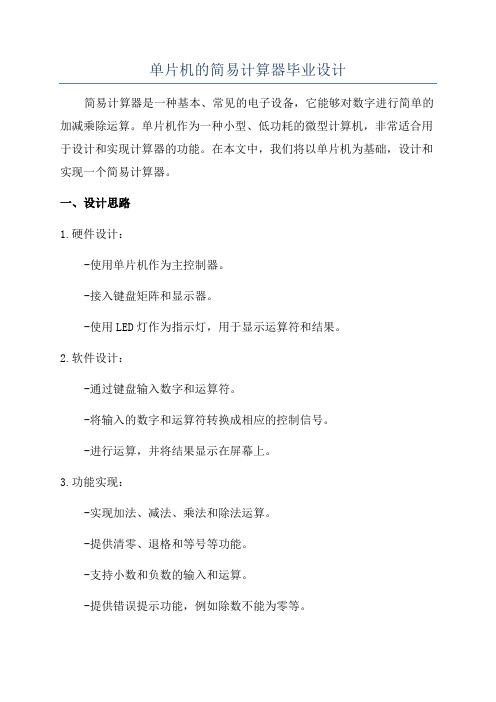
单片机的简易计算器毕业设计简易计算器是一种基本、常见的电子设备,它能够对数字进行简单的加减乘除运算。
单片机作为一种小型、低功耗的微型计算机,非常适合用于设计和实现计算器的功能。
在本文中,我们将以单片机为基础,设计和实现一个简易计算器。
一、设计思路1.硬件设计:-使用单片机作为主控制器。
-接入键盘矩阵和显示器。
-使用LED灯作为指示灯,用于显示运算符和结果。
2.软件设计:-通过键盘输入数字和运算符。
-将输入的数字和运算符转换成相应的控制信号。
-进行运算,并将结果显示在屏幕上。
3.功能实现:-实现加法、减法、乘法和除法运算。
-提供清零、退格和等号等功能。
-支持小数和负数的输入和运算。
-提供错误提示功能,例如除数不能为零等。
二、具体实现1.硬件实现:-将键盘矩阵的行和列与单片机的IO口相连,通过扫描来检测按键的输入。
-将显示器与单片机的IO口相连,通过控制引脚来发送和接收数据。
-将LED灯与单片机的IO口相连,设置相应的引脚状态来显示不同的指示信号。
2.软件实现:-使用C语言编写程序,通过中断和轮询的方式,实现键盘输入的检测和数据的读取。
-将读取到的数据进行解析,并根据不同的按键进行相应的操作。
-根据输入的数字和运算符,进行相应的运算并输出结果。
3.功能实现:-加法、减法、乘法和除法运算可以通过相应的算法实现,例如加法可以通过循环和位运算来实现。
-清零功能可以将运算结果和输入的数字都清零,退格功能可以删除输入的最后一个数字或运算符。
-支持小数运算可以在运算过程中进行进位和进位操作,支持负数运算可以通过判断运算符来进行相应的处理。
-错误提示功能可以通过对输入的数据进行检查和判断来实现,例如判断除数是否为零。
三、总结通过上述的设计和实现,我们可以成功地设计和制作一个单片机的简易计算器。
通过这个计算器,用户可以进行简单的加减乘除运算,同时还具备清零、退格、小数和负数等功能。
这个计算器可以应用在日常生活中的计算场景,方便用户进行各种简单的运算操作。
单片机简易计算器设计
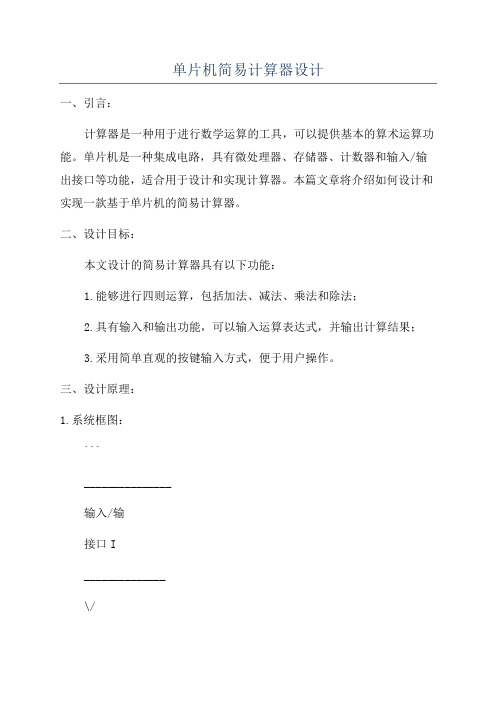
单片机简易计算器设计一、引言:计算器是一种用于进行数学运算的工具,可以提供基本的算术运算功能。
单片机是一种集成电路,具有微处理器、存储器、计数器和输入/输出接口等功能,适合用于设计和实现计算器。
本篇文章将介绍如何设计和实现一款基于单片机的简易计算器。
二、设计目标:本文设计的简易计算器具有以下功能:1.能够进行四则运算,包括加法、减法、乘法和除法;2.具有输入和输出功能,可以输入运算表达式,并输出计算结果;3.采用简单直观的按键输入方式,便于用户操作。
三、设计原理:1.系统框图:```_______________输入/输接口I______________\/_______________单片机芯(CPU______________```2.硬件设计:使用单片机来处理计算表达式和输出计算结果。
输入/输出接口IC负责处理用户输入和显示输出。
单片机芯片是整个计算器系统的核心,负责执行算术运算的逻辑。
3.软件设计:(1)初始化:设置单片机芯片工作环境,包括引脚配置、定时器设置等。
(2)输入处理:使用按键输入方式获取用户输入的数值和运算符,按下等号键时开始计算。
(3)运算处理:根据输入的数值和运算符进行相应的运算操作,得出计算结果。
(4)输出显示:将计算结果输出到显示装置上。
四、实现步骤:1.硬件实现:根据设计原理中的系统框图,采购和连接合适的输入/输出接口IC以及单片机芯片。
2.软件编程:(1)初始化:根据单片机芯片的型号和文档,编写初始化程序,包括引脚配置、定时器设置等。
(2)输入处理:编写输入处理程序,包括按键输入方式、数值和运算符的提取等。
(3)运算处理:编写运算处理程序,根据输入的数值和运算符,实现相应的运算逻辑。
(4)输出显示:编写输出显示程序,将计算结果输出到显示装置上。
3.实验验证:将硬件和软件进行调试和验证,确保计算器可以正常工作并满足设计目标。
4.优化改进:根据实验结果,对计算器进行优化和改进,提升计算器的性能和用户体验。
基于51单片机的简易计算器设计
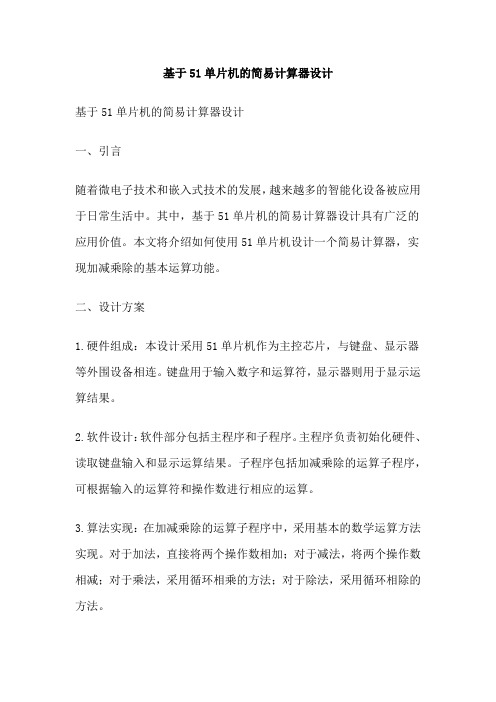
基于51单片机的简易计算器设计基于51单片机的简易计算器设计一、引言随着微电子技术和嵌入式技术的发展,越来越多的智能化设备被应用于日常生活中。
其中,基于51单片机的简易计算器设计具有广泛的应用价值。
本文将介绍如何使用51单片机设计一个简易计算器,实现加减乘除的基本运算功能。
二、设计方案1.硬件组成:本设计采用51单片机作为主控芯片,与键盘、显示器等外围设备相连。
键盘用于输入数字和运算符,显示器则用于显示运算结果。
2.软件设计:软件部分包括主程序和子程序。
主程序负责初始化硬件、读取键盘输入和显示运算结果。
子程序包括加减乘除的运算子程序,可根据输入的运算符和操作数进行相应的运算。
3.算法实现:在加减乘除的运算子程序中,采用基本的数学运算方法实现。
对于加法,直接将两个操作数相加;对于减法,将两个操作数相减;对于乘法,采用循环相乘的方法;对于除法,采用循环相除的方法。
三、实验结果在实验中,我们成功地使用51单片机设计了一个简易计算器,实现了加减乘除的基本运算功能。
在测试过程中,我们输入了不同的数字和运算符,得到了正确的运算结果。
同时,我们也测试了计算器的稳定性,发现其在连续运算时表现良好,没有出现明显的误差或故障。
四、结论基于51单片机的简易计算器设计具有简单易行、实用性强等优点。
通过实验测试,我们验证了其可行性和稳定性。
此外,该设计还可以根据需要进行扩展和优化,例如增加更多的运算功能、优化算法等。
未来,我们可以进一步研究如何提高计算器的运算速度和精度,以及如何将其应用于更多的实际应用场景中。
五、改进意见与展望1.增加更多的运算功能:例如实现括号、开方、指数等高级运算,满足更复杂的数学计算需求。
2.优化算法:针对现有的加减乘除运算算法进行优化,提高运算速度和精度。
例如采用更高效的除法算法,减少运算时间。
3.增加存储功能:在计算器中加入存储单元,使得用户可以在多个步骤之间进行数据传递和保存。
4.增强人机交互界面:优化显示器的显示效果,增加用户输入的便捷性,提高用户体验。
单片机课程设计报告——简易电子计算器
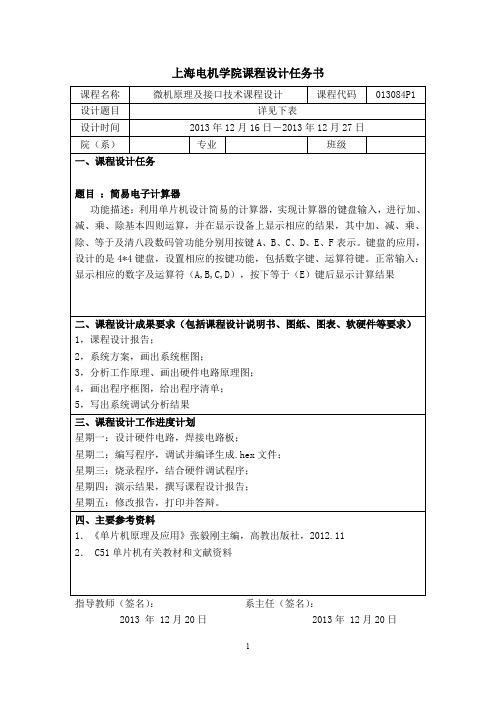
1、设计要求
通过软件编程,利用 AT89S51 单片机实现设计简易的计算器功能,即可实现 简单加减乘除。实现计算器的键盘输入,进行加、减、乘、除基本四则运算,并 在显示设备上显示相应的结果。要求撰写课程设计报告,并在设计报告中列写系 统方案,画出系统框图;然后分析工作原理、画出硬件电路原理图;同时画出程 序框图,给出程序清单;之后,写出系统调试分析结果。并在最后写出对于本次 课程设计的心得体会。
二、课程设计成果要求(包括课程设计说明书、图纸、图表、软硬件等要求) 1,课程设计报告; 2,系统方案,画出系统框图; 3,分析工作原理、画出硬件电路原理图; 4,画出程序框图,给出程序清单; 5,写出系统调试分析结果 三、课程设计工作进度计划 星期一:设计硬件电路,焊接电路板; 星期二:编写程序,调试并编译生成.hex 文件; 星期三:烧录程序,结合硬件调试程序; 星期四:演示结果,撰写课程设计报告; 星期五:修改报告,打印并答辩。 四、主要参考资料 1.《单片机原理及应用》张毅刚主编,高教出版社,2012.11 2. C51 单片机有关教材和文献资料
指导教师(签名): 2013 年 12 月 20 日
系主任(签名): 2013 年 12 月 20 日
1
目录
1、设计要求.................................................................................................................. 1 2、简易计算器系统设计.............................................................................................. 1 3、简易计算器系统硬件设计...................................................................................... 1
51单片机简易计算器设计报告
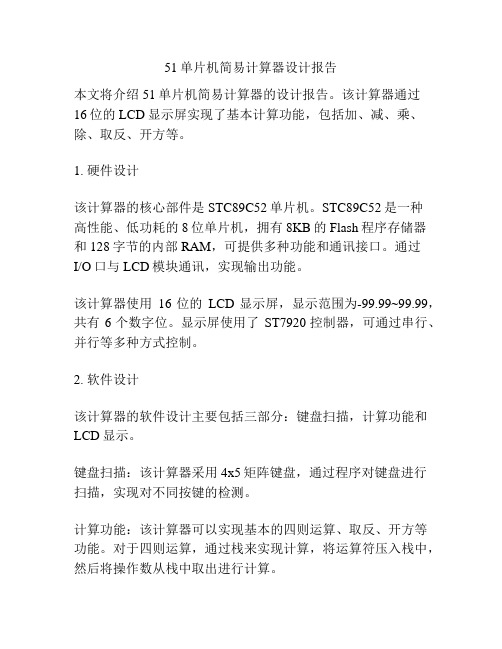
51单片机简易计算器设计报告
本文将介绍51单片机简易计算器的设计报告。
该计算器通过
16位的LCD显示屏实现了基本计算功能,包括加、减、乘、除、取反、开方等。
1. 硬件设计
该计算器的核心部件是STC89C52单片机。
STC89C52是一种
高性能、低功耗的8位单片机,拥有8KB的Flash程序存储器和128字节的内部RAM,可提供多种功能和通讯接口。
通过
I/O口与LCD模块通讯,实现输出功能。
该计算器使用16位的LCD显示屏,显示范围为-99.99~99.99,共有6个数字位。
显示屏使用了ST7920控制器,可通过串行、并行等多种方式控制。
2. 软件设计
该计算器的软件设计主要包括三部分:键盘扫描,计算功能和LCD显示。
键盘扫描:该计算器采用4x5矩阵键盘,通过程序对键盘进行扫描,实现对不同按键的检测。
计算功能:该计算器可以实现基本的四则运算、取反、开方等功能。
对于四则运算,通过栈来实现计算,将运算符压入栈中,然后将操作数从栈中取出进行计算。
LCD显示:该计算器使用16位的LCD显示屏,通过程序控制数据和命令的传输,将计算结果显示在LCD屏幕上。
3. 总结
通过对51单片机简易计算器的设计报告,可以看出该计算器实现了基本的计算功能,通过硬件设计和软件设计相结合,将计算器的功能实现得十分完整。
该计算器的设计初步掌握了51单片机的应用,有助于后续项目的开展。
单片机实践简易计算器实验报告

单片机实践简易计算器实验报告本次实验的目的是通过单片机实现一个简易计算器,实现加减乘除四则运算。
在实验过程中,我们使用了STC89C52单片机,通过编写程序实现计算器的功能。
实验步骤:1. 确定硬件电路连接我们需要确定硬件电路连接。
本次实验使用的是STC89C52单片机,需要将其与LCD1602液晶屏、4x4矩阵键盘、蜂鸣器等硬件连接。
具体连接方式如下:STC89C52单片机:P0口:连接LCD1602液晶屏的数据线D0-D7P1口:连接LCD1602液晶屏的控制线RS、RW、EP2口:连接4x4矩阵键盘的行线R1-R4P3口:连接4x4矩阵键盘的列线C1-C4P4口:连接蜂鸣器2. 编写程序接下来,我们需要编写程序实现计算器的功能。
程序主要分为以下几个部分:(1)LCD1602液晶屏初始化(2)4x4矩阵键盘扫描(3)计算器功能实现(4)LCD1602液晶屏显示结果3. 调试程序编写完程序后,我们需要进行调试。
在调试过程中,我们需要注意以下几点:(1)检查硬件连接是否正确(2)检查程序是否有语法错误(3)检查程序是否能够正常运行4. 实验结果经过调试,我们成功实现了一个简易计算器。
在使用过程中,用户可以通过4x4矩阵键盘输入数字和运算符,计算器会自动进行计算,并在LCD1602液晶屏上显示结果。
同时,计算器还具有清零、退格等功能,方便用户进行操作。
总结:通过本次实验,我们学习了单片机的基本原理和编程方法,掌握了如何使用单片机实现一个简易计算器。
同时,我们还学习了如何进行硬件电路连接和程序调试,提高了我们的实践能力和动手能力。
基于51单片机简易计算器课程设计报告
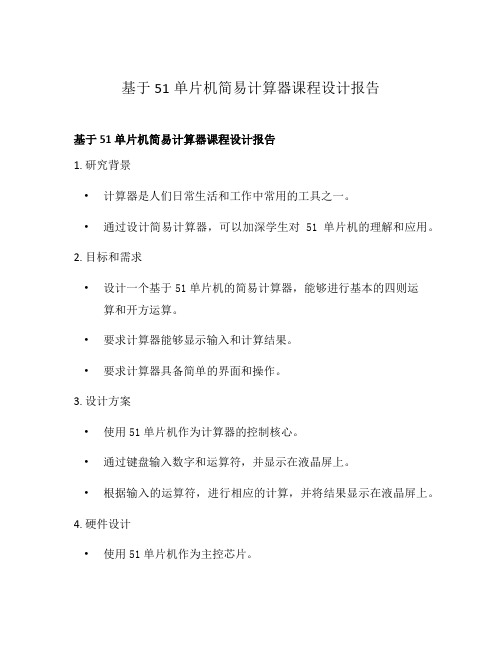
基于51单片机简易计算器课程设计报告
基于51单片机简易计算器课程设计报告
1. 研究背景
•计算器是人们日常生活和工作中常用的工具之一。
•通过设计简易计算器,可以加深学生对51单片机的理解和应用。
2. 目标和需求
•设计一个基于51单片机的简易计算器,能够进行基本的四则运算和开方运算。
•要求计算器能够显示输入和计算结果。
•要求计算器具备简单的界面和操作。
3. 设计方案
•使用51单片机作为计算器的控制核心。
•通过键盘输入数字和运算符,并显示在液晶屏上。
•根据输入的运算符,进行相应的计算,并将结果显示在液晶屏上。
4. 硬件设计
•使用51单片机作为主控芯片。
•连接液晶屏模块,用于显示输入和计算结果。
•连接键盘模块,用于输入数字和运算符。
5. 软件设计
•使用C语言进行编程。
•设计主程序,包括初始化、输入处理和计算输出等功能。
•设计函数,实现基本的四则运算和开方运算。
6. 实验结果
•成功设计并实现了基于51单片机的简易计算器。
•可以正常进行基本的四则运算和开方运算。
•输入和计算结果能够准确显示在液晶屏上。
7. 总结与展望
•通过设计这个简易计算器,学生对51单片机的理解和应用能力有了提高。
•下一步可以考虑增加更多的功能,如科学计算和数据存储等。
以上是本次基于51单片机简易计算器课程设计的报告。
通过这个实验,学生对51单片机的应用能力得到了提升,进一步增强了对计算器的理解。
在未来的课程设计中,可以进一步拓展功能,提升计算器的实用性和功能性。
单片机设计实验报告简单计算器的设计
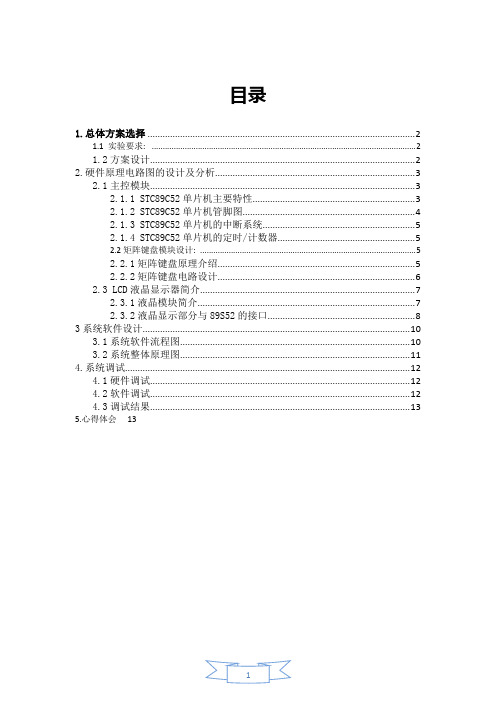
目录1.总体方案选择 (2)1.1 实验要求: (2)1.2方案设计 (2)2.硬件原理电路图的设计及分析 (3)2.1主控模块 (3)2.1.1 STC89C52单片机主要特性 (3)2.1.2 STC89C52单片机管脚图 (4)2.1.3 STC89C52单片机的中断系统 (5)2.1.4 STC89C52单片机的定时/计数器 (5)2.2矩阵键盘模块设计: (5)2.2.1矩阵键盘原理介绍 (5)2.2.2矩阵键盘电路设计 (6)2.3 LCD液晶显示器简介 (7)2.3.1液晶模块简介 (7)2.3.2液晶显示部分与89S52的接口 (8)3系统软件设计 (10)3.1系统软件流程图 (10)3.2系统整体原理图 (11)4.系统调试 (12)4.1硬件调试 (12)4.2软件调试 (12)4.3调试结果 (13)5.心得体会131.总体方案选择1) 1.1 实验要求:2)通过小键盘实现数据的输入, 并在LED数码管上显示3)实现+、-、*、/4)在LED数码管上显示结果并有清零, 退出功能1.2方案设计本系统以STC89C52单片机为控制核心, 对系统进行初始化, 主要完成对键盘的响应、液晶显示灯功能的控制, 起到总控和协调各模块之间工作的作用。
单片机通过检测键盘读取使用者按下对用功能的按键, 然后通过单片机内部运放把运算的结果显示在液晶屏幕上。
图1-1系统结构框图本系统结构如图1-1所示, 本设计可分为以下模块: 单片机主控模块、键盘模块、功率放大模块、闹铃模块、按键设置模块。
下面对各个模块的设计方案逐一进行论证分析。
2.硬件原理电路图的设计及分析2.1主控模块STC89C52有40个引脚, 4个8位并行I/O口, 1个全双工异步串行口, 同时内含5个中断源, 2个优先级, 2个16位定时/计数器。
STC89C52的存储器系统由4K的程序存储器(掩膜ROM), 和128B的数据存储器(RAM)组成。
单片机课程设计-计算器

未来发展方向
智能化:引入人工 智能技术,实现语 音识别、图像识别 等功能
便携化:设计更小、 更轻、更薄的计算 器,方便携带和使 用
网络化:实现计算 器与互联网的连接 ,实现远程控制和 数据传输
环保化:采用环保 材料和节能设计, 降低能耗和污染
感谢您的观看
汇报人:
计算器模式:支持科学计算器模式和普 通计算器模式
错误提示:当
体积小:单片机计算器体积小,便于携带和使用 功耗低:单片机计算器功耗低,可以长时间使用 功能强大:单片机计算器功能强大,可以进行各种复杂的计算 可编程:单片机计算器可编程,可以根据需要进行功能扩展和修改
显示模块
液晶显示屏:用 于显示计算结果 和操作提示
驱动电路:控制 液晶显示屏的显 示效果
接口电路:连接 液晶显示屏与单 片机
背光控制:调节 液晶显示屏的亮 度和对比度
输入模块
键盘输入:通过键盘输入数字 和运算符号
液晶显示:显示输入结果和操 作提示
电源模块:提供稳定的电源供 应
复位模块:用于系统复位和初 始化
弦等
算法设计:采 用模块化设计, 每个功能模块 对应一个算法
算法实现:使 用C语言编写算 法,实现计算
器功能
测试与调试:编 写测试程序,对 算法进行测试和 调试,确保算法 正确性和稳定性
中断服务程序
功能:处理突发事件,如按键、定时器等 结构:包括中断请求、中断响应、中断处理、中断返回等步骤 特点:速度快、实时性强、效率高 应用:广泛应用于各种单片机系统中,如计算器、遥控器等
存储模块
存储容量:根据计算器功能 需求选择合适的存储容量
存储芯片:用于存储计算器 程序和数据
存储方式:采用静态存储或 动态存储方式
51单片机简易计算器设计报告(一)

51单片机简易计算器设计报告(一)背景介绍在数字化时代,计算器作为一种简单易用的工具,越来越得到人们的关注和热爱。
而基于51单片机的简易计算器,不仅可以成为一种学习电子技术的手段,还具有满足简单计算需求的实用性。
设计思路本计算器采用键盘输入和数码管输出的电路设计,为用户提供加、减、乘、除、小数点、退位以及等于等功能。
1.键盘输入采用矩阵键盘的方式,将所有按键按行列排列,并利用51单片机中断方式来读取键值。
2.计算处理通过编写相应的程序代码,计算出用户输入的两个数值及操作符的结果,并将结果存储在数据缓存器中,最后将其输出至数码管。
3.数码管显示根据计算结果的数据类型,将其经过相应的转换处理后,通过数码管将结果输出至用户。
设计技术1.软件编写软件编写方面,采用汇编语言进行编写,代码总长度为2.2KB 左右。
其中,以中断方式读取键值、实现数值存储与判断、计算处理、数码管的结果输出等作为关键点进行编写。
2.硬件搭建硬件搭建方面,需要按照电路图进行搭建,并将51单片机与相关周边电路进行连接。
根据设计思路,将键盘、数码管、电源、指示灯等设备按照需求进行连接。
可改进之处虽然 51单片机的简易计算器的搭建能够满足基本计算需求,但其在以下几方面还有可改进之处:•添加计算科学函数,如三角函数、对数函数等。
•改进操作方式,使其更加符合人体工程学原理。
•添加储存器,使用户能够将计算结果进行存储和调用。
总结通过本次对基于51单片机的简易计算器的设计与实现,我们深入了解了电子技术的基本概念和硬件搭建原理,并了解到了简单嵌入式系统的工作原理。
虽然该计算器在功能和效率方面还有待改进,但对于初学者来说,其对于电子技术的学习和实验还是很有价值和意义的。
•编写的汇编代码过于繁琐,可考虑使用高级语言编写以提高效率和易读性。
•在电路搭建时需注意布线的合理性,尽量避免出现干扰和信号损失的问题。
综上所述,基于51单片机的简易计算器的设计和实现虽存在一些不足,但还是很有价值的。
单片机实训计算器报告

一、引言随着科技的飞速发展,单片机技术作为嵌入式系统的重要组成部分,已经在各个领域得到了广泛的应用。
为了提高学生对单片机技术的理解和实践能力,我们开展了单片机实训课程。
本次实训报告以设计一个简易计算器为例,详细介绍单片机在计算器中的应用及其设计过程。
二、实训目的1. 熟悉单片机的基本原理和编程方法。
2. 掌握单片机外围设备的接口技术。
3. 培养学生的实际动手能力和创新意识。
三、实训内容1. 设计要求本次实训要求设计一个基于单片机的简易计算器,能够实现以下功能:(1)加、减、乘、除四则运算;(2)结果显示在LCD1602显示屏上;(3)具有简单的错误处理功能。
2. 系统组成本计算器系统主要由以下几部分组成:(1)AT89C51单片机:作为系统的核心控制器,负责控制整个计算器的运行;(2)LCD1602显示屏:用于显示输入的数字、运算符和计算结果;(3)矩阵键盘:用于输入数字和运算符;(4)按键:用于控制计算器的开关、清零和退出等功能。
3. 硬件设计(1)AT89C51单片机:选用AT89C51单片机作为核心控制器,具有丰富的I/O端口和片内资源,可以满足计算器的需求。
(2)LCD1602显示屏:通过单片机的PORTD端口与LCD1602显示屏相连,实现数据显示功能。
(3)矩阵键盘:采用4x4矩阵键盘,将行线连接到单片机的PB0-PB3端口,列线连接到PB4-PB7端口。
(4)按键:设置三个按键,分别用于控制计算器的开关、清零和退出功能。
4. 软件设计(1)初始化:首先对单片机的I/O端口、LCD1602显示屏和矩阵键盘进行初始化。
(2)键盘扫描:通过扫描矩阵键盘,获取用户输入的数字和运算符。
(3)运算逻辑处理:根据用户输入的数字和运算符,进行相应的运算。
(4)结果显示:将计算结果显示在LCD1602显示屏上。
(5)错误处理:当输入错误或发生溢出时,显示错误信息。
四、实训过程1. 硬件电路搭建:根据设计要求,将AT89C51单片机、LCD1602显示屏、矩阵键盘和按键连接到一起,搭建计算器的硬件电路。
基于51单片机的简易教学计算器设计

基于51单片机的简易教学计算器设计设计目的:本设计旨在基于51单片机实现一个简易的教学计算器,可以进行基本的四则运算,并具备一些辅助功能,帮助学生进行数学计算和学习。
设计要求:1.显示器:使用液晶显示器(LCD)来显示操作数和计算结果。
2.键盘输入:设计一个按键矩阵作为输入设备,用于输入数字和操作符。
3.四则运算:实现加法、减法、乘法和除法四种基本运算。
4.辅助功能:提供开平方、取倒数等辅助功能。
5.界面友好:界面清晰、操作简单。
硬件设计:1.51单片机(AT89C52):作为计算器的核心芯片,控制程序运行和与外围设备的交互。
2.液晶显示器(LCD):用于显示操作数和计算结果。
3.按键矩阵:用于输入数字和操作符。
4.运算模块:用于进行四则运算和辅助功能计算。
软件设计:1.系统初始化:初始化51单片机和LCD屏幕,设置键盘矩阵的引脚。
2.输入处理:通过按键矩阵检测用户输入,并将输入的字符存储在缓冲区中。
3.表达式计算:根据用户输入的表达式,通过逆波兰表达式算法将其转换为后缀表达式,并进行计算得到结果。
4.显示结果:将计算结果显示在LCD屏幕上。
5.辅助功能:根据用户选择的辅助功能,进行相应的计算,并显示结果。
6.重置功能:提供清零功能,将计算器的状态和显示结果重置。
操作流程:1.系统初始化:开机时,系统进行初始化,屏幕显示“计算器”字样。
2.输入操作数和操作符:用户通过按键矩阵输入操作数和操作符。
3.计算结果:用户输入“=”符号后,计算器根据输入的表达式进行计算,并将结果显示在LCD屏幕上。
4.辅助功能:在计算结果显示完成后,用户可选择进行辅助功能,如开平方、取倒数等操作。
5.重置功能:用户可通过按下“C”键进行重置,将计算器状态和显示结果清零。
总结:本设计基于51单片机实现了一个简易的教学计算器,具备基本的四则运算功能和一些辅助功能。
其使用液晶显示器作为显示设备,利用按键矩阵进行输入操作,通过逆波兰表达式算法进行计算,并将结果显示在屏幕上。
基于51单片机简易计算器课程设计报告

基于51单片机简易计算器课程设计报告引言:计算器是现代社会中常见的电子设备之一,它能够帮助人们进行各种数学运算,提高计算效率。
本文将介绍基于51单片机的简易计算器的设计过程及实现方法。
一、设计目标本次设计的目标是实现一个简易计算器,能够进行基本的加减乘除运算,并能够显示计算结果。
通过该设计,旨在加深学生对51单片机的理解,培养其实际操作能力。
二、硬件设计1. 电源模块:采用稳压电源模块,提供稳定的电压给单片机及其他电路模块。
2. 单片机模块:采用51单片机,作为计算器的核心控制模块,负责接收按键输入、进行运算和显示结果。
3. 按键模块:设计合适的按键电路,用于输入数字和操作符。
4. 显示模块:采用数码管或液晶显示屏,显示计算结果。
5. 连接线:将各个模块连接起来,确保信号的传输畅通。
三、软件设计1. 初始化:设置单片机的工作模式、端口方向和初始状态。
2. 按键扫描:通过轮询的方式检测按键是否被按下,若有按键按下则进行相应的处理。
3. 输入处理:根据按键的顺序和操作符的位置进行输入的处理,将输入的数字和操作符分别存储在相应的变量中。
4. 运算处理:根据输入的操作符进行相应的运算,得出计算结果。
5. 结果显示:将计算结果通过数码管或液晶显示屏进行显示。
6. 清零处理:在计算结果显示完毕后,对相关的变量进行清零处理,以便进行下一次的计算。
四、功能实现1. 加法运算:通过按下"+"按键,输入第一个数字,再按下"="按键,输入第二个数字,最后按下"="按键,计算并显示结果。
2. 减法运算:通过按下"-"按键,输入第一个数字,再按下"="按键,输入第二个数字,最后按下"="按键,计算并显示结果。
3. 乘法运算:通过按下"*"按键,输入第一个数字,再按下"="按键,输入第二个数字,最后按下"="按键,计算并显示结果。
单片机课程设计报告(简易计算机)
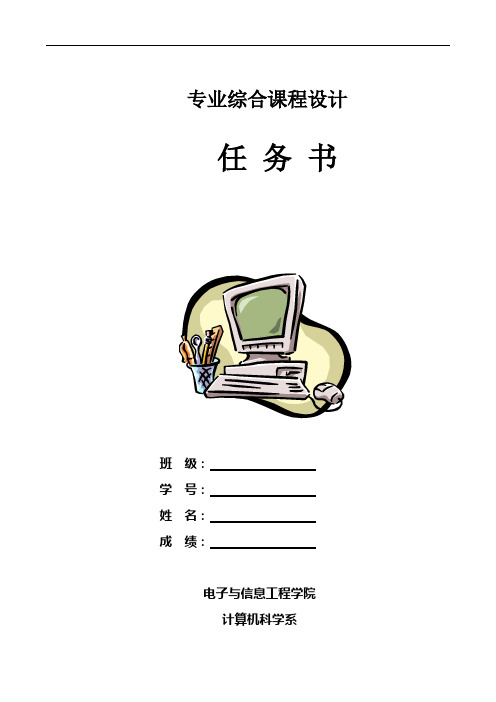
专业综合课程设计任务书班级:学号:姓名:成绩:电子与信息工程学院计算机科学系图1.2 图1.3图1.42.3键盘电路这部分有16个button构成4*4矩阵,通过p1口进行行扫描方式实现按键的读取。
硬件电路图如图1.4。
2.4总体硬件图如图1.5图1.53 软件详细设计3.1键盘扫描子程序要进行数据的计算就必须进行数据的输入,也就是确定按键输入的数值是什么,这就需要对键盘进行行扫描,从而确定究竟是那个键按下。
对于键盘的扫描,既可以使用行扫描也可以使用列扫描,这里采用行扫描的方法完成对键盘的扫描行扫描就是逐行扫描键盘,看那一行有键按下,再通过返回的见马来确定究竟是哪个按键按下。
对第一行扫描就置p1.0为底电平,其余p1口为高电平,如果有按键按下,则p1口的值就会变为别的值,再由新值来确定是那个键按下。
程序流程图如图1.6图1.6dd:mov r0,#0f7h mov r1,#0cc:mov a,r0 mov p1,amov a,p1 mov r2,asetb c mov r3,#4bb:rlc a jnc aaee:inc r1 djnz r3,bbmov a,r0 setb crrc a mov r0,ajc cc ljmp ddKAOO:LJMP KAO BBB2:LJMP BB2aa:lcall mm mov a,p1xrl a,r2 nz eeff:mov a,p1 xrl a,r2jz ff MOV A,51HCJNE A,#1,BBB2RET3.4主程序及其他部分程序下图为主程序流程图:主要有:初始化子程序,清屏子程序,固定字符显示,单元定义,端口定义,字模部分。
主程序:RG 0LJMP STARTSTART:MOV SP,#60HLCALL INT ;调用初始化子程序START1:LCALL CLEAR ;调用清屏子程序初始化子程序:INT: MOV COM,#0C0H ;设置显示起始行为第一行LCALL PRM0LCALL PRR0MOV COM,#3FH ;开显示设置LCALL PRM0LCALL PRR0RET清屏子程序:CLEAR:MOV R4,#00H。
基于51单片机简易计算器课程设计报告(一)

基于51单片机简易计算器课程设计报告(一)基于51单片机简易计算器课程设计报告1. 介绍在本次课程设计中,我设计了一个基于51单片机的简易计算器。
本报告将会详细介绍该计算器的设计思路、功能实现以及课程设计中遇到的问题与解决方法。
2. 设计思路功能需求•支持基本的加、减、乘、除运算•具备数字输入与显示功能•具备清零和等于功能•具备连续计算功能硬件设计本计算器的硬件设计主要包括51单片机、LCD显示模块以及按键输入模块。
其中,51单片机负责控制计算器的逻辑,LCD显示模块用于显示计算结果和用户输入,按键输入模块用于接收用户的输入。
软件设计计算器的软件设计主要分为以下几个部分: - 初始化:初始化51单片机、LCD模块以及按键模块。
- 按键扫描:通过扫描按键模块,获取用户的输入。
- 数字输入与显示:根据用户输入,将数字显示在LCD上。
- 运算逻辑:根据用户输入的运算符和数字,执行相应的计算操作,并将结果显示在LCD上。
3. 功能实现初始化在初始化阶段,我们需要初始化51单片机的GPIO口、LCD模块以及按键模块。
具体的初始化代码如下:// 初始化51单片机的GPIO口// 初始化LCD模块// 初始化按键模块按键扫描为了获取用户的输入,我们需要通过按键模块进行扫描。
具体的按键扫描代码如下:// 扫描按键模块// 如果检测到按键按下,则进行相应的处理数字输入与显示当用户按下数字键时,我们将获取到的数字输入缓存起来,并将其显示在LCD上。
具体的数字输入与显示代码如下:// 获取按键输入的数字// 将数字添加到输入缓存// 将输入缓存显示在LCD上运算逻辑当用户按下运算符键时,我们需要根据输入的数字和运算符执行相应的计算操作,并将结果显示在LCD上。
具体的运算逻辑代码如下:// 获取运算符输入// 根据运算符和输入的数字执行相应的计算操作// 将计算结果显示在LCD上清零和等于功能为了提升用户体验,我们还可以添加清零和等于功能。
单片机课程设计报告-简易计算器
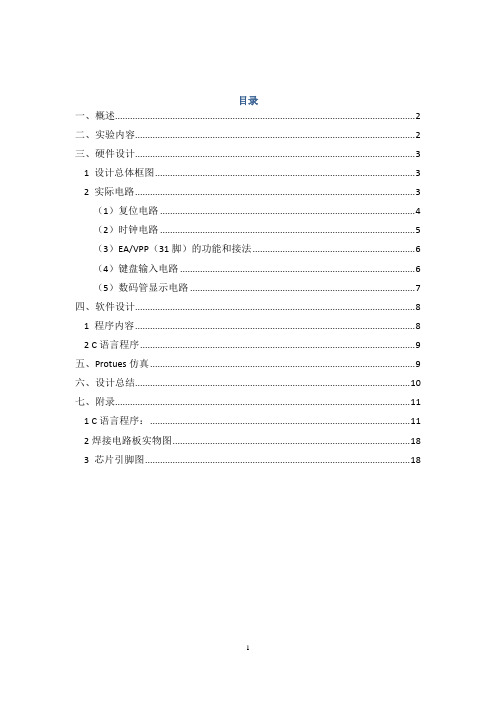
目录一、概述 (2)二、实验内容 (2)三、硬件设计 (3)1 设计总体框图 (3)2 实际电路 (3)(1)复位电路 (4)(2)时钟电路 (5)(3)EA/VPP(31脚)的功能和接法 (6)(4)键盘输入电路 (6)(5)数码管显示电路 (7)四、软件设计 (8)1 程序内容 (8)2 C语言程序 (9)五、Protues仿真 (9)六、设计总结 (10)七、附录 (11)1 C语言程序: (11)2焊接电路板实物图 (18)3 芯片引脚图 (19)一、概述单片机课程设计是一门实践课程,要求学生具有制作调试单片机最小系统及外设的能力,能够掌握单片机内部资源的使用。
单片机课程设计内容包括硬件设计、制作及软件编写、调试,学生在熟练掌握焊接技术的基础上,能熟练使用单片机软件开发环境Keil C51编程调试,并使用STC ISP调试工具采用串口下载方式联调制作的单片机最小系统。
单片机课程设计题目包含基本部分及扩展部分,基本部分即单片机最小系统部分,扩展部分是对单片机内部资源及外部IO口的功能扩展,使制作的单片机系统具有一定的功能。
二、实验内容自制一个单片机最小系统,包括串口下载、复位电路,采用外部小键盘输入数据,能够实现加法、乘法及一个科学计算,计算结果显示在四位一体的数码管上。
三、硬件设计1 设计总体框图2实际电路在单片机系统中,复位电路是非常关键的,当程序跑飞(运行不正常)或死机(停止运行)时,就需要进行复位。
MCS-5l 系列单片机的复位引脚RST(第9 管脚)出现2个机器周期以上的高电平时,单片机就执行复位操作。
如果RST 持续为高电平,单片机就处于循环复位状态。
复位操作通常有两种基本形式:上电自动复位和开关复位。
上电瞬间,电容两端电压不能突变,此时电容的负极和RESET 相连,电压全部加在了电阻上,RESET 的输入为高,芯片被复位。
随之+5V 电源给电容充电,电阻上的电压逐渐减小,最后约等于0,芯片正常工作。
单片机简易计算器课程设计

单片机简易计算器课程设计一、课程目标知识目标:1. 学生能理解单片机的基本结构及其工作原理,掌握简易计算器的硬件组成。
2. 学生能掌握C语言编程的基本语法,运用其编写简易计算器的程序代码。
3. 学生能了解简易计算器的工作流程,理解其功能模块的设计与实现。
技能目标:1. 学生能够运用所学知识,设计并搭建简易计算器的硬件电路。
2. 学生能够运用C语言编写简易计算器的程序,实现加、减、乘、除等基本运算功能。
3. 学生能够对计算器程序进行调试和优化,解决实际问题。
情感态度价值观目标:1. 学生通过课程学习,培养对单片机及编程的兴趣,激发探究精神。
2. 学生在团队协作中学会沟通、分享,培养合作意识,增强团队精神。
3. 学生能够认识到所学知识在生活中的应用,体会科技改变生活的意义。
课程性质:本课程为实践性较强的课程,要求学生动手操作,结合理论知识进行实际应用。
学生特点:学生已具备一定的电子基础和编程知识,对单片机有一定了解,但实践能力有待提高。
教学要求:注重理论与实践相结合,引导学生主动参与,培养其动手能力和解决问题的能力。
通过课程学习,使学生能够将所学知识运用到实际项目中,提高其综合素质。
二、教学内容1. 硬件知识:- 单片机基本结构:介绍51单片机的内部结构、工作原理及其引脚功能。
- 硬件电路设计:讲解简易计算器的硬件组成,包括按键、显示屏、电源等模块。
2. 软件编程:- C语言基础:复习C语言基本语法,包括变量、数据类型、运算符、控制结构等。
- 编程实践:根据简易计算器的功能需求,编写程序代码,实现基本运算功能。
3. 系统设计与实现:- 系统设计:分析简易计算器的功能模块,设计程序流程图。
- 系统实现:指导学生搭建硬件电路,编写程序代码,实现简易计算器的功能。
4. 调试与优化:- 调试方法:教授程序调试方法,培养学生解决问题的能力。
- 优化策略:讨论程序优化策略,提高计算器性能。
教学内容安排与进度:1. 第1周:单片机基本结构及硬件电路设计。
基于51单片机的简易计算器设计

基于51单片机的简易计算器设计一、引言计算器是一种执行基本数学运算的电子设备,现在市面上有各种类型的计算器,从小型的手持计算器到大型的科学计算器。
本设计基于51单片机设计了一种简易计算器,可以实现加法、减法、乘法和除法等基本运算。
二、设计思路1.系统硬件设计本设计使用的51单片机芯片选择了常用的STC89C52芯片,具有强大的功能和稳定性。
外设有键盘、数码管和LCD液晶显示屏。
2.系统软件设计系统的软件设计基于C语言进行,使用51单片机的汇编语言和C语言进行编程。
软件主要分为键盘输入处理、运算处理和结果显示三个部分。
三、系统硬件设计1.键盘输入部分使用4x4矩阵键盘作为输入设备,将键盘的4行4列分别接入到51单片机的4个IO口上,通过行列扫描的方式来检测按键的状态。
2.数码管显示部分使用共阳极的数码管来显示结果,通过提供适当的电压和信号控制来显示所需的数字。
3.LCD液晶显示屏为了方便用户查看输入和结果,本设计还使用了LCD液晶显示屏。
通过串口通信将结果传输到液晶显示屏上进行显示。
四、系统软件设计1.键盘输入处理通过行列扫描的方式检测键盘的按键状态,当检测到按键按下时,将对应的按键值存储起来。
2.运算处理根据用户的输入进行相应的运算处理。
根据检测到的按键值进行不同的运算操作,如加法、减法、乘法和除法。
3.结果显示将运算的结果通过串口通信传输到LCD液晶显示屏上进行显示。
五、系统实现1.硬件连接将键盘的行列引脚接到51单片机的对应IO口上,数码管和LCD液晶显示屏也分别连接到单片机的IO口上。
2.软件编码通过C语言编写系统软件,包括键盘输入处理、运算处理和结果显示三个模块。
3.调试测试将编写好的软件烧录到单片机上,通过键盘输入进行测试,并观察数码管和LCD液晶显示屏上的输出结果。
六、总结本设计基于51单片机实现了一个简易计算器,通过键盘输入进行基本的运算操作,并将结果通过数码管和LCD液晶显示屏进行显示。
单片机的简易计算器毕业设计
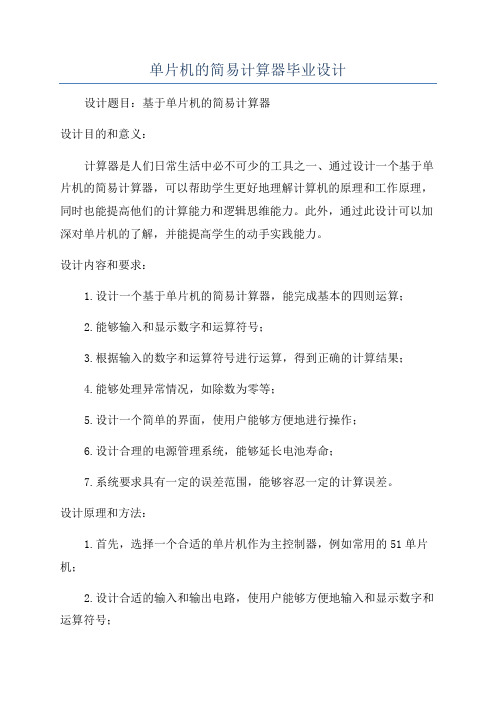
单片机的简易计算器毕业设计设计题目:基于单片机的简易计算器设计目的和意义:计算器是人们日常生活中必不可少的工具之一、通过设计一个基于单片机的简易计算器,可以帮助学生更好地理解计算机的原理和工作原理,同时也能提高他们的计算能力和逻辑思维能力。
此外,通过此设计可以加深对单片机的了解,并能提高学生的动手实践能力。
设计内容和要求:1.设计一个基于单片机的简易计算器,能完成基本的四则运算;2.能够输入和显示数字和运算符号;3.根据输入的数字和运算符号进行运算,得到正确的计算结果;4.能够处理异常情况,如除数为零等;5.设计一个简单的界面,使用户能够方便地进行操作;6.设计合理的电源管理系统,能够延长电池寿命;7.系统要求具有一定的误差范围,能够容忍一定的计算误差。
设计原理和方法:1.首先,选择一个合适的单片机作为主控制器,例如常用的51单片机;2.设计合适的输入和输出电路,使用户能够方便地输入和显示数字和运算符号;3.利用单片机的IO口进行数字和运算符号的输入和输出控制;4.设计算法,根据输入的数字和运算符号进行正确的四则运算,并得到正确的计算结果;5.根据实际情况进行运算结果的显示和存储,可以使用LCD液晶显示模块或LED数码管进行显示;6.设计异常处理程序,处理除数为零等异常情况;7.设计合理的电源管理系统,合理利用低功耗模式和休眠模式,延长电池寿命;8.对计算结果进行一定的误差范围控制,使其能够容忍一定的计算误差。
设计步骤和流程:1.确定设计的硬件平台和软件开发环境;2.进行电路设计,包括输入和输出电路的设计;3.进行程序开发,包括输入和输出控制、四则运算和异常处理程序的编写;4.进行整体系统调试,测试输入和输出的功能是否正常;5.进行算法调试,测试四则运算的正确性;6.进行界面设计,设计一个简单易用的用户界面;7.进行电源管理系统的设计和调试,测试功耗和电池寿命;8.完善设计文档,撰写设计报告。
设计结果和展示:通过以上设计,完成了一个基于单片机的简易计算器。
- 1、下载文档前请自行甄别文档内容的完整性,平台不提供额外的编辑、内容补充、找答案等附加服务。
- 2、"仅部分预览"的文档,不可在线预览部分如存在完整性等问题,可反馈申请退款(可完整预览的文档不适用该条件!)。
- 3、如文档侵犯您的权益,请联系客服反馈,我们会尽快为您处理(人工客服工作时间:9:00-18:30)。
简易计算器摘要:计算器是人们的日常生活中是最常见的电子产品之一,它应用极广、发展迅猛,并且不断出现着拥有更加强大功能的计算器。
为了解和研究计算器,本次课设设计制作了一个简易计算器,能够在十四位的计算范围内进行“+”、“-”、“*”、“/”的基本运算,能进行负数以及小数点后两位的精确结果显示。
该计算器以AT89C51单片机芯片作为核心。
采用LCD1602工业字符液晶进行显示。
完成的计算器经过检验能够完整的实现预设功能,各种细节完善,具有很高的使用价值。
关键词:单片机;简易计算器;AT89C51;LCD1602Simple CalculatorAbstract:Calculator is People's Daily life is one of the most common electronic products, used very wide, developing rapidly, and constantly appear more powerful function with have calculators. In order to understand and study calculator, this class set design made a simple calculator, can the calculation in within 14 "+" and "-" and "*", "/" the basic computing, can carry out negative and two decimal places accurate results are shown. This calculator with AT89C51 chips as the core. Using liquid LCD1602 industrial characters displayed. Complete calculator after inspection can complete realization, various details preset functions to perfect, have high use value.Keywords:MCU; Simple calculator;AT89C51;LCD1602目录中文摘要............................................................1英文摘要............................................................2单片机课程设计......................................................4 1 课程设计任务.....................................................41.1 主要功能设计................................................41.2 任务目的....................................................42 整体设计方案......................................................42.1 方案论证....................................................42.2 系统框图....................................................53 硬件电路的设计...................................................63.1 计算机Protel总图............................................63.2 显示电路设计方案............................................93.3 键盘设计方案................................................93.4 复位电路设计...............................................103.5 晶振电路设计...............................................104 控制软件设计....................................................114.1 程序时序总图...............................................114.2 液晶显示软件设计...........................................124.3 键盘输入软件设计...........................................134.4 计算函数设置...............................................155 系统调试........................................................185.1 硬件调试...................................................185.2 软件调试...................................................18参考文献...........................................................20个人小结...........................................................21附录...............................................................24附录1..........................................................24附录2..........................................................251课程设计任务1.1 主要功能设计以AT89C51单片机芯片为核心来制作一个简易计算器,外部由4*4矩阵键盘和一个LCD1602工业字符型液晶显示屏构成,内部由一块AT89C51单片机构成,通过软件编程可实现简单加减乘除。
1.2 任务目的通过本次课程设计提高我们的单片机硬件设计、软件编程能力,自主学习到更多的单片机应用知识。
2 整体设计方案2.1 方案论证计算器电路包括三个部分:显示电路、4*4键扫描电路、单片机微控制电路。
具体如下:(1)LCD显示电路LCD1602作为一个成熟的产品,使用简单,模式固定,便于移植到各种类型的程序,但是初学者往往要注意结合LCD本身的时序图来完善初始化程序。
又以其微功耗、体积小、显示内容丰富、超薄轻巧的诸多优点,故采用LCD.(2)4*4键盘扫描电路一般常采用3 种方法读取键值。
一种是中断式,外两种是扫描法和反转法。
中断式:在键盘按下时产生一个外部中断通知CPU,并由中断处理程序通过不同的地址读取数据线上的状态,判断哪个案件被按下。
本实验采用中断式实现用户键盘接口。
扫描法:对键盘上的某一行送低电平,其他行为高电平,然后读取列值。
若列值中有一位是低,则表明该行与低电平对应列的键被按下;否则,扫描下一行。
反转法:先将所有行扫描线输出低电平,读列值。
若列值有一位是低,则表明有键按下,读列值;然后所有列扫描线输出低电平,再读行值。
根据读到的值组合就可以查表1 得到的键码。
因为编程的方式,本次设计采用逐行扫描来读取键值,方便程序编写。
(3)单片机微控制电路:微控制电路就是以AT89C51为核心的控制核心,主要注意晶振电路的接法和复位电路的接法。
2.2 系统框图系统框图2.13 硬件电路的设计3.1 计算机Protel总图简易计算器电路原理图1.1 3.2 显示电路设计方案LCD1602型液晶(1)显示特性●单5V电源电压,低功耗,长寿命,可靠性高●内置192种字符(160个5*7点阵字符和32个5*10点阵字符)●具有64个字节的自定义字符RAM,可自定义8个5*8点阵字符●或四个5*11点阵字符●显示方式:STN、半透、正显●驱动方式:1/16DUTY,1/5BIAS●视角方式:6点●背光方式:底部LED●通讯方式:4位或8位并口可选●标准的接口特性,适配MC51和M6800系列MPU的操作时序(2)接口定义8~13DB1~DB6底4位三态、双向数据总线1~6位14DB7高4位三态、双向数据总线7位(最高位)(也是busy flag)(3)寄存器选择控制表RS R/W操作说明00写入指令寄存器(清除屏等)01读busy flag(DB7),以及读取位址计数器(DB0~DB6)值10写入数据寄存器(显示各字型等)11从数据寄存器读取数据(4)液晶显示电路接线图本次设计中15,16号脚分别接电源接地开启背光,DB0~DB7对应P1口,2号脚接电源,1和3脚接地。
3.3 键盘设计方案12mm*12mm*8mm规格4*4矩阵排布键盘(1)按键设置图共设置16 个键,其中数字键0~9 共十个,符号健有加号键、减号键、等于号、清除键。
操作设备是四行四列共16键的简单键盘。
其分布如图所示。
(2)按键功能1~9为数字输入;ON/C为清除健;"+"、"-"、"*"、"\"、"="为符号输入;(3)键盘连接图键盘对应连接如图所示,接单片机P3口,在焊接过程中要注意短接虚焊,同时P3口接入510欧电阻进行上拉。
3.4 复位电路设计途中的RC为延时电路,只要RST端出现2个机器周期的高电平就可以使单片机复位,单片机复位后RST端出现低电平。
3.5 晶振电路设计单片机内部设有一个反向放大器构成的振荡器,18脚和19脚分别为振荡电路的输入和输出端,时钟由内部产生,定时器件为石英晶体和电容组成的并联谐振回路,电容C2,C3取值在5-30PF;Y1的取值在1.2~12M之间选取。
